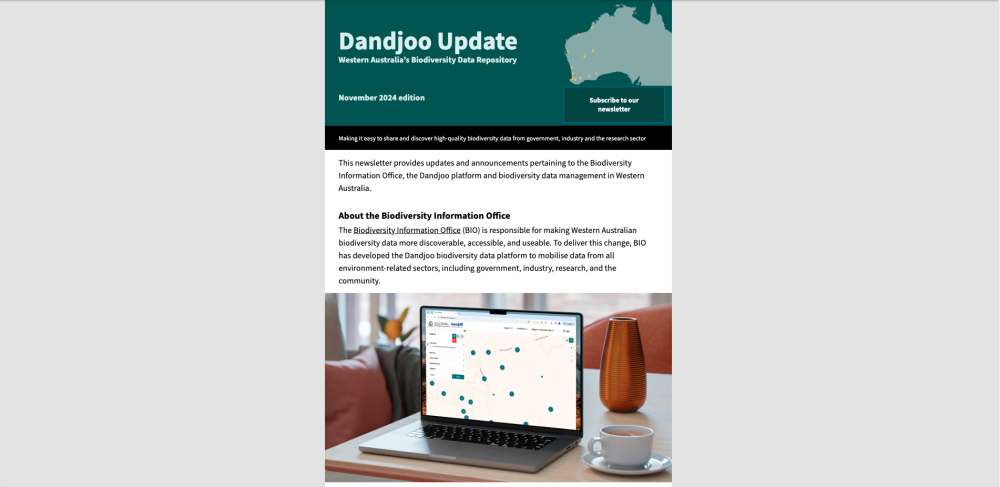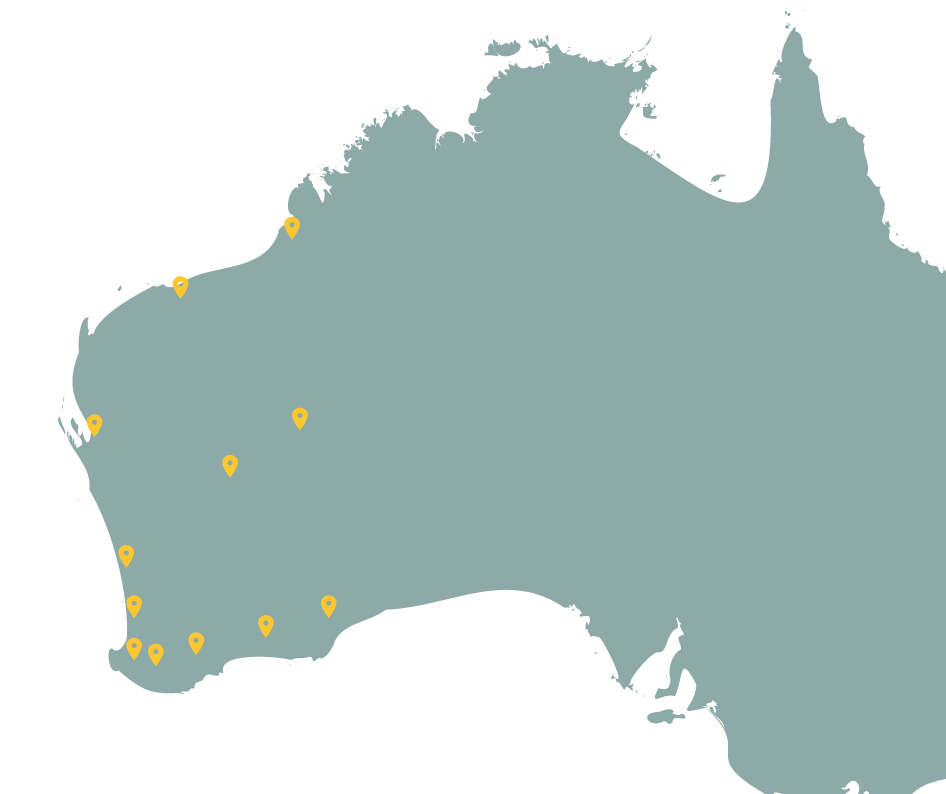Frequently asked questions
Why is my species missing from Dandjoo?
If you are unable to find any data about a particular species, it may be restricted if the species has a threatened or priority code, in line with the Biodiversity Conservation Act 2016.
For more information, see How can I see data about threatened and other sensitive species?
How do I attribute data I’ve sourced from Dandjoo?
When citing information obtained from Dandjoo, it is important to attribute it to the designated Rights Holder. The Rights Holder for each record is indicated in any data extracts downloaded from Dandjoo.
You should also reference Dandjoo as the source, citing DBCA as the publisher – for instance ‘The Department of Biodiversity, Conservation and Attractions [2024], Dandjoo search accessed on the [date of search]’.
How is the data in Dandjoo licensed?
The data in Dandjoo is generally provided under a CC BY 4.0 licence, except where:
- the record indicates it has been provided by the Department of Water and Environmental Regulation’s Index of Biodiversity Surveys for Assessment (IBSA) program (which allows for bespoke licensing arrangements); or
- the data relates to a threatened species or ecological community under the Biodiversity Conservation Act 2016, where limitations to data sharing apply.
If you’re uncertain about the licensing conditions that apply, contact us and we’ll help you out.
What do I do if I have a question about a specific record or dataset?
We’ll be happy to help you out if you send us a message. Make a note of the Record ID or dataset name you’re asking about and we’ll look into it for you. If we can’t give you an answer right away, we’ll get in touch with the original data provider on your behalf.
How can I see data about threatened and other sensitive species?
Information relating to threatened species records is not publicly available via BIO. General, obfuscated records of threatened species records are available through location searches in the species list function. BIO is trialling the delivery of threatened species records for approved internal users, but at the current time expanded threatened species information still needs to be requested via DBCA’s Species and Communities Branch. Threatened ecological communities information will also need to be requested via DBCA’s Species and Communities Branch.
BIO is also working with other States and Territories to develop a national best-practice approach to sharing threatened species data to the public with reduced geographic precision. When complete, this approach will be implemented in Dandjoo, safely allowing public users to view threatened species records.
Who can submit data to Dandjoo?
At launch, datasets were collected from industry surveys and the research sector. We recognise the value of all data sources, including citizen science contributions. As Dandjoo evolves, we will explore ways to incorporate data from a broader range of sources while giving users greater control over the types of data they wish to view.
Do get in touch if you’re interested in providing data – we’re keen to talk to you.
Does Dandjoo contain data from the Department of Water and Environmental Regulation’s Index of Biodiversity Surveys for Assessment (IBSA)?
Dandjoo has been pre-populated with data provided directly by the private sector - this data is considerably richer than that submitted for IBSA and covers a longer time period.
The BIO team is currently working on ingestion of the entire collection of historical IBSA datasets, and these will appear in Dandjoo as each is processed.
Is Dandjoo’s data the same data that DBCA used to provide on the NatureMap platform?
The datasets previously provided via NatureMap are now available in Dandjoo. (We’ve also updated some of these datasets where refreshed data is available, and will continue to work with data custodians to update them periodically.)
Dandjoo’s collection is considerably larger than that previously available in NatureMap, as it also includes new datasets from industry, researchers, and regulatory agencies.
Does Dandjoo contain both terrestrial and marine data?
Most records in Dandjoo relate to terrestrial species, since much of the data is generated by industry processes - for example surveys undertaken for regulatory approvals. However, marine data is not entirely absent - for example, many marine species are represented in records from the Western Australian Museum.
What data can I find in Dandjoo?
BIO actively sources data from a range of industry, research, and government providers – our collection is always growing. You can read about our data contributors and our Frequently Asked Questions to find out more.
At present, much of the data you’ll find in Dandjoo is species observation data – records of a particular species observed or sampled at a specific location at a specific date. With the release of new systematic survey data search and visualisation options, survey data will be accessible and downloadable. BIO is also working on extending visualisation options and searchability for vegetation association data.
In addition to exploring the data via our web platform, you can download a current snapshot of the entire species observation database in our Download Centre, as well as other resources including useful spatial layers.
It’s important to note that observations of threatened and priority species aren’t publicly displayed in Dandjoo. However, the BIO team is working with other Australian jurisdictions on an approach to provide these records with reduced precision, and on processes for sharing specific locations safely with authorised users. The BIO team is also trialling delivery of more precise location data for these species for internal users, but at the current time threatened species information should still be requested via DBCA’s Species and Communities Branch.
Can I connect to Dandjoo via an API?
Yes, check out our API documentation for details, and do tell us about what you're working on - we’re keen to hear about how you’re using the platform, and how we can support your project.
I have an idea for a new feature – can you implement it in the next version of Dandjoo?
We want to make sure future development is informed by users, and are keen to have your input. You can also contact us to find out more about our forthcoming User Consultation Committee, and how your sector is represented.
How is Dandjoo different to other data sharing platforms?
For data providers, we’ve taken an approach that you shouldn’t need to use a template, provide a set number of fields, or - where possible - reformat date and location information data in your dataset to meet a prescribed format. We want to make it as easy as possible for you to submit data - if you’re providing species occurrence data, you can even use our self-service quality assurance tools to map columns in your dataset to those recognised by Dandjoo.
We’re also committed to maintaining the integrity of your data; if we have any questions about specific records in your dataset, we’ll let you know so you can decide whether you’d like us to make a correction or redact a record.
For data users our map-based interface is designed to be user-friendly and provide a familiar experience for those who have used other biodiversity data platforms. In addition, it is underpinned by a number of data quality innovations.
Data is reviewed by our team of curatorial staff prior to publication, and mapped to 54 key fields from multiple internationally ratified data standards. Dandjoo makes use of the Darwin Core, Dublin Core and Australian Biodiversity Information Standards. Dandjoo also retains all the original data fields submitted by the data provider, so we can extend those mappings as they are added in the future.
The platform also contains a number of data sets that have never been released before, including data from the private sector, and the data undergoes routine curation to ensure that taxonomic name and conservation code information is kept up-to-date.
Does my business have to submit data to Dandjoo as part of a regulatory process?
There are no requirements to submit data directly to Dandjoo.
We’re currently working with the Environment Online team at the Department of Water and Environmental Regulation on the implementation of an integrated data environment. This will mean that data submitted as part of a regulatory process will flow seamlessly into the platform. However, if your organisation has a collection of historical biodiversity data and would like to provide it to BIO, please do let us know.
Past Email Newsletters

Join the BIO newsletter and get updated first
Sign up for access to the latest developments at the Biodiversity Information Office, upcoming Dandjoo features, and our newest datasets.

